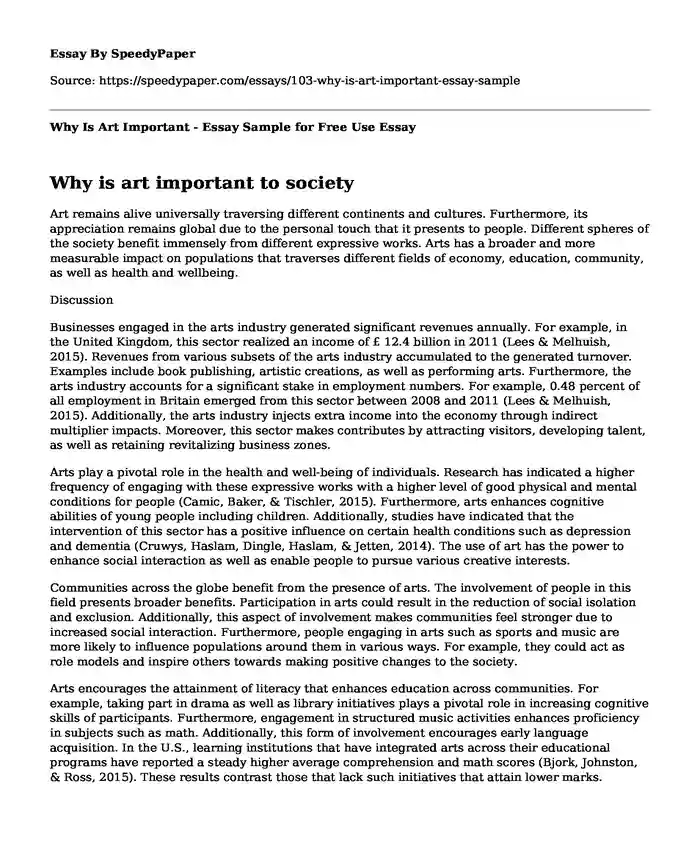Why is art important to society
Art remains alive universally traversing different continents and cultures. Furthermore, its appreciation remains global due to the personal touch that it presents to people. Different spheres of the society benefit immensely from different expressive works. Arts has a broader and more measurable impact on populations that traverses different fields of economy, education, community, as well as health and wellbeing.
Discussion
Businesses engaged in the arts industry generated significant revenues annually. For example, in the United Kingdom, this sector realized an income of £ 12.4 billion in 2011 (Lees & Melhuish, 2015). Revenues from various subsets of the arts industry accumulated to the generated turnover. Examples include book publishing, artistic creations, as well as performing arts. Furthermore, the arts industry accounts for a significant stake in employment numbers. For example, 0.48 percent of all employment in Britain emerged from this sector between 2008 and 2011 (Lees & Melhuish, 2015). Additionally, the arts industry injects extra income into the economy through indirect multiplier impacts. Moreover, this sector makes contributes by attracting visitors, developing talent, as well as retaining revitalizing business zones.
Arts play a pivotal role in the health and well-being of individuals. Research has indicated a higher frequency of engaging with these expressive works with a higher level of good physical and mental conditions for people (Camic, Baker, & Tischler, 2015). Furthermore, arts enhances cognitive abilities of young people including children. Additionally, studies have indicated that the intervention of this sector has a positive influence on certain health conditions such as depression and dementia (Cruwys, Haslam, Dingle, Haslam, & Jetten, 2014). The use of art has the power to enhance social interaction as well as enable people to pursue various creative interests.
Communities across the globe benefit from the presence of arts. The involvement of people in this field presents broader benefits. Participation in arts could result in the reduction of social isolation and exclusion. Additionally, this aspect of involvement makes communities feel stronger due to increased social interaction. Furthermore, people engaging in arts such as sports and music are more likely to influence populations around them in various ways. For example, they could act as role models and inspire others towards making positive changes to the society.
Arts encourages the attainment of literacy that enhances education across communities. For example, taking part in drama as well as library initiatives plays a pivotal role in increasing cognitive skills of participants. Furthermore, engagement in structured music activities enhances proficiency in subjects such as math. Additionally, this form of involvement encourages early language acquisition. In the U.S., learning institutions that have integrated arts across their educational programs have reported a steady higher average comprehension and math scores (Bjork, Johnston, & Ross, 2015). These results contrast those that lack such initiatives that attain lower marks.
Conclusion
The significance of arts cannot be understated. This sector plays an essential role in different segments of the community. The contribution of arts in the society through the economy remains evident in day-to-day life activities across nations globally. Additionally, populations benefit from enhanced health and wellbeing due to the increased social interaction that helps them to deal with conditions such as depression. Moreover, arts improve literacy levels through strengthening cognitive skills of participants.
References
Bjork, C., Johnston, D. K., & Ross, H. A. (2015). Taking teaching seriously: How liberal arts colleges prepare teachers to meet today's educational challenges in schools. New York, NY: Routledge.
Camic, P. M., Baker, E. L., & Tischler, V. (2015). Theorizing how art gallery interventions impact people with dementia and their caregivers. The Gerontologist, 56(6), 1033-1041.
Cruwys, T., Haslam, S. A., Dingle, G. A., Haslam, C., & Jetten, J. (2014). Depression and social identity: An integrative review. Personality and Social Psychology Review, 18(3), 215-238.
Lees, L., & Melhuish, C. (2015). Arts-led regeneration in the UK: The rhetoric and the evidence on urban social inclusion. European urban and regional studies, 22(3), 242-260.
Cite this page
Why Is Art Important - Essay Sample for Free Use. (2018, Mar 15). Retrieved from https://speedypaper.net/essays/103-why-is-art-important-essay-sample
Request Removal
If you are the original author of this essay and no longer wish to have it published on the SpeedyPaper website, please click below to request its removal:
- Free Essay Sample on Conditional Parenting
- Literary Essay Example on Moll Flanders and Keats's Poetry and Prose
- Why I Choose to Major in Accounting - Application Essay Example
- Essay Example on Handmade Company's Network Management and Security
- Essay Sample on Patient Self Determination Act
- Essay Example on Florida's Demographics
- Free Essay: Dual Admission Program
Popular categories





